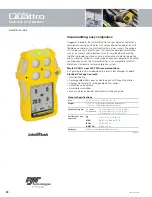
7
This detector helps monitor for the presence and concentration level of a certain specified airborne gas. Misuse may produce an
inaccurate reading, which means that higher levels of the gas being monitored may be present and could result in overexposure and
cause sickness or death. For proper use, see supervisor or User Instructions, or call Technical Service at 1-877-367-7891.
Location
A GD-6 mounting height is dependent upon the target gas.
If the target gas is lighter than air; methane (NG) or Hydrogen (H2), mount the GD-6 high on a wall or column (about one foot
down from the ceiling) in a central area where air movement is generally good.
If the target gas is heavier than air; propane (LP), mount the GD-6 low on a wall or column (about one foot above the floor) in a
central area where air movement is generally good.
The unit, on average, can cover about 900 sq. ft. (84 sq. meters). The coverage depends on air movement within the room or facility.
Extra detectors may be needed near any areas where people work or where the air is stagnant. Do NOT mount the GD-6 where the
normal ambient temperature is below below 0°F or exceeds 125°F (below -18
C or above 52
C).
High voltage relay terminals (120/240 VAC) are located within this detector, presenting a hazard to service technicians. Only qualified
technicians should open the detector case and service the internal circuits. Ensure power is removed from the detector relays prior to
servicing the unit. Failure to do so may result in sickness or death.
Installation
1.
The GD-6 mounts on a 4” square (or 4x4) electrical box supplied by the contractor. Do not mount the GD-6 inside another box,
unless it has good air flow through it.
2.
Connect the GD-6 to Class 2 power supply only. It is suggested to use a separate transformer for powering the unit or units
because of possible interference’s from other devices on the same power supply.
3.
Connect the GD-6 to the control cables with terminal plugs. When making connections, make sure the power is off.
4.
There are two terminals for Power: 12 to 24 VAC or 12 to 48 VDC, with no polarity preference.
5.
There are two terminals for the dry alarm relay contacts, again with no polarity preference. The alarm relay can switch up to 0.5
A 120 V, or 60 VA. The alarm relay is activated if gas reaches or exceeds the alarm settings. See OPERATION section of
these User Instructions for details on relay settings.
6.
The alarm relay can be configured to normally open (default) (N.O.) or normally closed (N.C.) and will activate if the gas
concentration exceeds alarm set point. It will deactivate once the gas concentration drops below the alarm set point. Note that
the “disable” setting will cause the alarm relay not to engage at all.
! WARNING
! WARNING








































